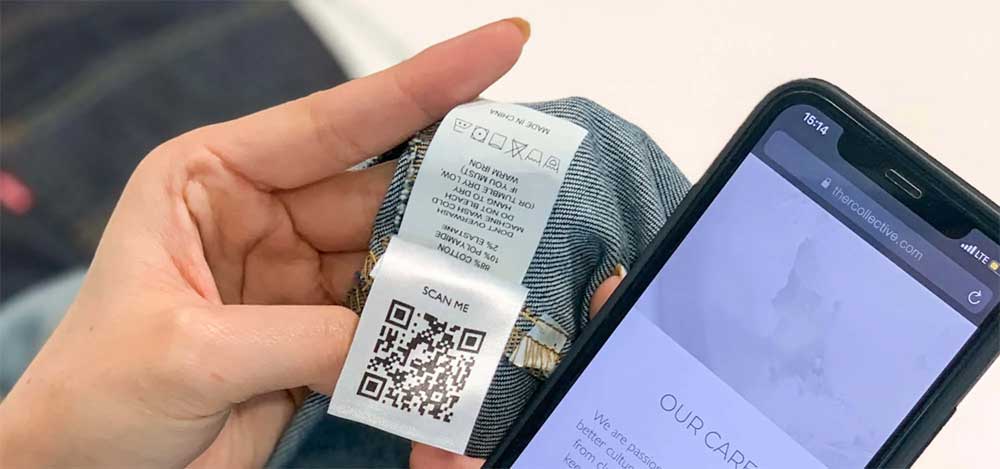The Benefits of Using QR Codes on Labels and Tags for Clothing
Quick Response (QR) codes have been a part of the modern technological landscape for years, and their integration into various sectors has changed the way businesses operate. One industry that has seen a burgeoning use of QR codes is the fashion sector, specifically on clothing labels and tags.
QR Codes on labels and tags for clothing are an innovative way for retail brands and clothing manufacturters and even cottage cloth designers, to share valuable information with shoppers in-store. They help enhance consumers’ first impression of your brand and improve the retail experience.
This addition is more than just a trend; it is transforming the consumer experience. Here are the compelling benefits of using QR codes on clothing tags:
Instant Access to Product Information: Customers can simply scan the QR Codes on labels and tags for clothing to receive detailed product information. This could include fabric care instructions, materials used, origin of the product, and even the story behind a particular piece.
Enhanced Customer Engagement: You can also use QR Codes on labels and tags for clothing to offer exclusive content such as behind-the-scenes videos, interviews with designers, or fashion show clips. This enriches the shopping experience and helps build a stronger emotional connection between consumers and brands.
Sustainability Transparency: As sustainability becomes a prime concern, brands can use QR Codes on labels and tags for clothing to share information about eco-friendly practices, ethical sourcing, and other sustainability efforts.
Streamlined Returns and Exchanges: QR Codes can simplify the return or exchange process. Scanning the code can direct customers to a page where they can request a return, print return labels, or find out more about the brand’s return policy.
Promotions and Discounts: Brands can offer special promotions, discounts, or loyalty rewards through QR Codes on labels and tags for clothing. When customers scan the tag, they can be taken to exclusive online sales or receive coupon codes for future purchases.
Anti-counterfeit Measures: Fashion is plagued by counterfeits. Brands can incorporate QR Codes as a method of authentication. A quick scan can verify the authenticity of the item, reassuring consumers of their purchase.
Social Sharing: Through QR Codes, customers can be directed to social media platforms where they can instantly share their new purchase, write reviews, or engage with the brand’s online community.
Real-time Inventory Management: For retailers, QR Codes on labels and tags for clothing can aid in real-time inventory tracking. This allows businesses to monitor stock levels, making supply chain management more efficient.
Simplified Shopping Experience: Imagine a world where fitting rooms are equipped with screens. A quick scan of the clothing’s QR Code could show customers different sizes or colors available, allowing for a seamless and enhanced shopping experience.
Feedback Loop: Brands can use QR Codes to solicit feedback. Understanding what customers like or dislike about a product can lead to better design decisions in the future.
Environmental Savings: By reducing the need for additional printed materials (like separate care instruction leaflets), QR Codes can minimize paper waste. Information is stored online, promoting a more eco-friendly shopping experience.
How to Create QR Codes on Labels and Tags for Clothing
QR Codes on labels and tags for clothing will use mainly a static QR Code as they last forever and generally cost nothing unless you want us to create in bulk. You can use tools like QR Codes Australia Static QR Code maker. When printing QR codes on clothing labels, keep the following tips in mind:
Pick the right format: Use PNG format for QR codes on clothing tags to ensure optimal image resolution.
Choose a scannable size: Ensure that the QR code is at least 2 cm x 2 cm in size to make it easily scannable by smartphones.
Consider contrast: Select a QR code color that contrasts with the fabric color to improve scannability.
Error correction level: Choose an appropriate error correction level usually 10 or above to ensure durability and scannability of the QR Code.
QR Codes on labels and tags for clothing offer a versatile way to engage customers and provide them with valuable information at every stage of their buying journey. They can be a powerful tool for enhancing brand-consumer interaction and improving overall customer satisfaction.
Marketing QR Codes on Labels and Tags for Clothing
By using a paid Dynamic QR Code and activating the Google UTM feature you can get a lot of additional tracking and information.
The secret of using a paid dynamic Qr Code is to organise your landing page to incorporate easy directions for viewing product information meaning you can use a few paid Dynamic QR Code on multiple products. 2 Dynamic QR Codes is only $22 AUD a year providing a range of information and stats.
A dynamic QR Code is built via a database which means the destination can be changed at any time and it can also provide statistics. You can download in PDF,PNG,SVG,EPS. To order your Dynamic QR Code go to our Dynamic QR Codes Generator
In conclusion, the integration of QR Codes on clothing labels and tags goes beyond a mere tech gimmick. It bridges the gap between the physical and digital, enhancing the customer’s shopping experience while offering brands multiple touchpoints for engagement.
As the digital age continues to evolve, such innovative implementations in the fashion industry signify a move towards a more informed, interactive, and sustainable future.

